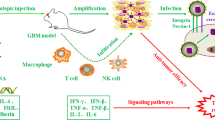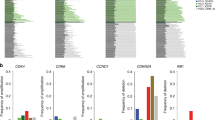Abstract
Malignant gliomas (MGs) are cancers with poor prognosis and limited therapeutic options. Herpes Simplex virus-1 thymidine kinase expressed from adenoviruses with prodrug ganciclovir (TK/GCV) is the best-characterized suicide gene therapy, whereas temozolomide (TMZ) is the first-line chemotherapy for MG. However, the potential of their combination has not been studied thoroughly. The aim of this study was to evaluate the therapeutic response of this combination and to study whether addition of valproic acid (VPA) could benefit the treatment outcome. Efficacies of different treatments were first studied in vitro in BT4C rat MG cells. Therapeutic assessment in vivo was done in an immunocompetent rat MG model for treatment efficacy and toxicity. In vitro, VPA was able to significantly enhance cytotoxicity and increase adenovirus-mediated transduction efficiency up to sevenfold. In vivo, rats receiving TK/GCV+TMZ had notably smaller tumors and enhanced survival (P<0.001) in comparison with control rats. However, VPA was not able to further enhance the treatment response in vivo. Leukocytopenia and thrombocytopenia were the major side effects. We conclude that careful optimization of the treatment schedules and doses of individual therapies are necessary to achieve an optimal therapeutic effect with TK/GCV+TMZ combination. No further in vivo benefit with VPA was observed.
This is a preview of subscription content, access via your institution
Access options
Subscribe to this journal
Receive 12 print issues and online access
$259.00 per year
only $21.58 per issue
Buy this article
- Purchase on Springer Link
- Instant access to full article PDF
Prices may be subject to local taxes which are calculated during checkout





Similar content being viewed by others
References
Stupp R, Hegi ME, Mason WP, van den Bent MJ, Taphoorn MJ, Janzer RC et al. Effects of radiotherapy with concomitant and adjuvant temozolomide versus radiotherapy alone on survival in glioblastoma in a randomised phase III study: 5-year analysis of the EORTC-NCIC trial. Lancet Oncol 2009; 10: 459–466.
Louis DN . Molecular pathology of malignant gliomas. Annu Rev Pathol 2006; 1: 97–117.
Lawler SE, Peruzzi PP, Chiocca EA . Genetic strategies for brain tumor therapy. Cancer Gene Ther 2006; 13: 225–233.
Maatta AM, Samaranayake H, Pikkarainen J, Wirth T, Yla-Herttuala S . Adenovirus mediated herpes simplex virus-thymidine kinase/ganciclovir gene therapy for resectable malignant glioma. Curr Gene Ther 2009; 9: 356–367.
Beumer JH, Tawbi H . Role of histone deacetylases and their inhibitors in cancer biology and treatment. Curr Clin Pharmacol 2010; 5: 196–208.
Qiu L, Kelso MJ, Hansen C, West ML, Fairlie DP, Parsons PG . Anti-tumour activity in vitro and in vivo of selective differentiating agents containing hydroxamate. Br J Cancer 1999; 80: 1252–1258.
Karagiannis TC, El-Osta A . Clinical potential of histone deacetylase inhibitors as stand alone therapeutics and in combination with other chemotherapeutics or radiotherapy for cancer. Epigenetics 2006; 1: 121–126.
Nagarajan RP, Costello JF . Epigenetic mechanisms in glioblastoma multiforme. Semin Cancer Biol 2009; 19: 188–197.
Bolden JE, Peart MJ, Johnstone RW . Anticancer activities of histone deacetylase inhibitors. Nat Rev Drug Discov 2006; 5: 769–784.
Chateauvieux S, Morceau F, Dicato M, Diederich M . Molecular and therapeutic potential and toxicity of valproic acid. J Biomed Biotechnol 2010; 2010: 479364.
Fan S, Maguire CA, Ramirez SH, Bradel-Tretheway B, Sapinoro R, Sui Z et al. Valproic acid enhances gene expression from viral gene transfer vectors. J Virol Methods 2005; 125: 23–33.
Segura-Pacheco B, Avalos B, Rangel E, Velazquez D, Cabrera G . HDAC inhibitor valproic acid upregulates CAR in vitro and in vivo. Genet Vaccines Ther 2007; 5: 10.
Khan Z, Akhtar M, Asklund T, Juliusson B, Almqvist PM, Ekstrom TJ . HDAC inhibition amplifies gap junction communication in neural progenitors: potential for cell-mediated enzyme prodrug therapy. Exp Cell Res 2007; 313: 2958–2967.
Van Nifterik KA, Van den Berg J, Slotman BJ, Lafleur MV, Sminia P, Stalpers LJ . Valproic acid sensitizes human glioma cells for temozolomide and gamma-radiation. J Neurooncol 2012; 107: 61–67.
Chen CH, Chang YJ, Ku MS, Chung KT, Yang JT . Enhancement of temozolomide-induced apoptosis by valproic acid in human glioma cell lines through redox regulation. J Mol Med (Berl) 2011; 89: 303–315.
Weller M, Gorlia T, Cairncross JG, van den Bent MJ, Mason W, Belanger K et al. Prolonged survival with valproic acid use in the EORTC/NCIC temozolomide trial for glioblastoma. Neurology 2011; 77: 1156–1164.
Pulkkanen KJ, Yla-Herttuala S . Gene therapy for malignant glioma: current clinical status. Mol Ther 2005; 12: 585–598.
McGivern RF, henschel D, Hutcheson M, Pangburn T . Sex difference in daily water consumption of rats: effect of housing and hormones. Physiol Behav 1996; 59: 653–658.
Simo M, Velasco R, Graus F, Verger E, Gil M, Pineda E et al. Impact of antiepileptic drugs on thrombocytopenia in glioblastoma patients treated with standard chemoradiotherapy. J Neurooncol 2012; 108: 451–458.
Gotfryd K, Skladchikova G, Lepekhin EA, Berezin V, Bock E, Walmod PS . Cell type-specific anti-cancer properties of valproic acid: independent effects on HDAC activity and Erk1/2 phosphorylation. BMC Cancer 2010; 10: 383.
Burgess AJ, Pavey S, Warrener R, Hunter LJ, Piva TJ, Musgrove EA et al. Up-regulation of p21(WAF1/CIP1) by histone deacetylase inhibitors reduces their cytotoxicity. Mol Pharmacol 2001; 60: 828–837.
Ryu CH, Yoon WS, Park KY, Kim SM, Lim JY, Woo JS et al. Valproic acid downregulates the expression of MGMT and sensitizes temozolomide-resistant glioma cells. J Biomed Biotechnol 2012; 2012: 987495.
Stander M, Dichgans J, Weller M . Anticonvulsant drugs fail to modulate chemotherapy-induced cytotoxicity and growth inhibition of human malignant glioma cells. J Neurooncol 1998; 37: 191–198.
Osuka S, Takano S, Watanabe S, Ishikawa E, Yamamoto T, Matsumura A . Valproic acid inhibits angiogenesis in vitro and glioma angiogenesis in vivo in the brain. Neurol Med Chir (Tokyo) 2012; 52: 186–193.
Atmaca A, Al-Batran SE, Maurer A, Neumann A, Heinzel T, Hentsch B et al. Valproic acid (VPA) in patients with refractory advanced cancer: a dose escalating phase I clinical trial. Br J Cancer 2007; 97: 177–182.
van Breemen MS, Rijsman RM, Taphoorn MJ, Walchenbach R, Zwinkels H, Vecht CJ . Efficacy of anti-epileptic drugs in patients with gliomas and seizures. J Neurol 2009; 256: 1519–1526.
Rocca A, Minucci S, Tosti G, Croci D, Contegno F, Ballarini M et al. A phase I-II study of the histone deacetylase inhibitor valproic acid plus chemoimmunotherapy in patients with advanced melanoma. Br J Cancer 2009; 100: 28–36.
Wagner JM, Hackanson B, Lubbert M, Jung M . Histone deacetylase (HDAC) inhibitors in recent clinical trials for cancer therapy. Clin Epigenet 2010; 1: 117–136.
Tsai HC, Wei KC, Tsai CN, Huang YC, Chen PY, Chen SM et al. Effect of valproic acid on the outcome of glioblastoma multiforme. Br J Neurosurg 2012; 26: 347–354.
Stout SC, Owens MJ, Lindsey KP, Knight DL, Nemeroff CB . Effects of sodium valproate on corticotropin-releasing factor systems in rat brain. Neuropsychopharmacology 2001; 24: 624–631.
Loscher W . Basic pharmacology of valproate: a review after 35 years of clinical use for the treatment of epilepsy. CNS Drugs 2002; 16: 669–694.
Kim YK, Kim NH, Hwang JW, Song YJ, Park YS, Seo DW et al. Histone deacetylase inhibitor apicidin-mediated drug resistance: involvement of P-glycoprotein. Biochem Biophys Res Commun 2008; 368: 959–964.
Tabe Y, Konopleva M, Contractor R, Munsell M, Schober WD, Jin L et al. Up-regulation of MDR1 and induction of doxorubicin resistance by histone deacetylase inhibitor depsipeptide (FK228) and ATRA in acute promyelocytic leukemia cells. Blood 2006; 107: 1546–1554.
Rainov NG, Fels C, Droege JW, Schafer C, Kramm CM, Chou TC . Temozolomide enhances herpes simplex virus thymidine kinase/ganciclovir therapy of malignant glioma. Cancer Gene Ther 2001; 8: 662–668.
Westphal M, Yla-Herttuala S, Martin J, Warnke P, Menei P, Eckland D et al. Adenovirus-mediated gene therapy with sitimagene ceradenovec followed by intravenous ganciclovir for patients with operable high-grade glioma (ASPECT): a randomised, open-label, phase 3 trial. Lancet Oncol 2013; 14: 823–833.
Immonen A, Vapalahti M, Tyynela K, Hurskainen H, Sandmair A, Vanninen R et al. AdvHSV-tk gene therapy with intravenous ganciclovir improves survival in human malignant glioma: a randomised, controlled study. Mol Ther 2004; 10: 967–972.
Laerum OD, Rajewsky MF, Schachner M, Stavrou D, Haglid KG, Haugen A . Phenotypic properties of neoplastic cell lines developed from fetal rat brain cells in culture after exposure to ethylnitrosourea in vivo. Z Krebsforsch Klin Onkol Cancer Res Clin Oncol 1977; 89: 273–295.
Tyynela K, Sandmair AM, Turunen M, Vanninen R, Vainio P, Kauppinen R et al. Adenovirus-mediated herpes simplex virus thymidine kinase gene therapy in BT4C rat glioma model. Cancer Gene Ther 2002; 9: 917–924.
Hedman M, Hartikainen J, Syvanne M, Stjernvall J, Hedman A, Kivela A et al. Safety and feasibility of catheter-based local intracoronary vascular endothelial growth factor gene transfer in the prevention of postangioplasty and in-stent restenosis and in the treatment of chronic myocardial ischemia: phase II results of the Kuopio Angiogenesis Trial (KAT). Circulation 2003; 107: 2677–2683.
Sandmair AM, Turunen M, Tyynela K, Loimas S, Vainio P, Vanninen R et al. Herpes simplex virus thymidine kinase gene therapy in experimental rat BT4C glioma model: effect of the percentage of thymidine kinase-positive glioma cells on treatment effect, survival time, and tissue reactions. Cancer Gene Ther 2000; 7: 413–421.
Paxinos G, Watson C, Pennisi M, Topple A . Bregma, lambda and the interaural midpoint in stereotaxic surgery with rats of different sex, strain and weight. J Neurosci Methods 1985; 13: 139–143.
Stedt H, Alasaarela L, Samaranayake H, Pikkarainen J, Maatta AM, Kholova I et al. Specific inhibition of SRC kinase impairs malignant glioma growth in vitro and in vivo. Mol Ther Nucleic Acids 2012; 1: e19.
Acknowledgements
We thank Sari Järveläinen, Tiina Koponen, Riina Liikala, Joonas Malinen, Anne Martikainen, Anneli Miettinen, Mervi Nieminen and Seija Sahrio for their skillful technical assistance. Dr Johanna Närväinen (Biomedical NMR research group, A. I. Virtanen Institute for Molecular Sciences, University of Eastern Finland) is acknowledged for her assistance in MRI issues. We also thank Ark Therapeutics Ltd. for providing Ad.HSV-TK virus for the study. This study was supported by grants from Cancer Foundation of Northern Savo, Duodecim, Finnish Academy, Kuopio University Hospital, University of Eastern Finland and Ark Therapeutics Ltd.
Author information
Authors and Affiliations
Corresponding author
Ethics declarations
Competing interests
Haritha Samaranayake and Jere Pikkarainen were employees of Ark Therapeutics until end of 2012. The remaining authors declare no conflict of interest.
Additional information
Supplementary Information accompanies this paper on Gene Therapy website
Rights and permissions
About this article
Cite this article
Stedt, H., Samaranayake, H., Pikkarainen, J. et al. Improved therapeutic effect on malignant glioma with adenoviral suicide gene therapy combined with temozolomide. Gene Ther 20, 1165–1171 (2013). https://doi.org/10.1038/gt.2013.46
Received:
Revised:
Accepted:
Published:
Issue Date:
DOI: https://doi.org/10.1038/gt.2013.46



